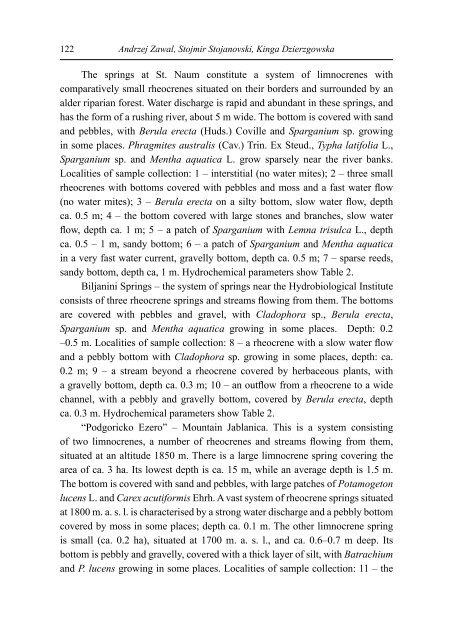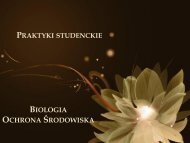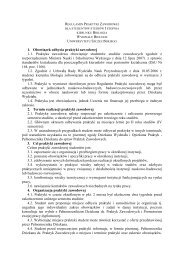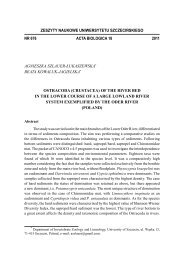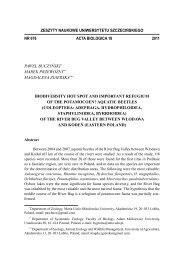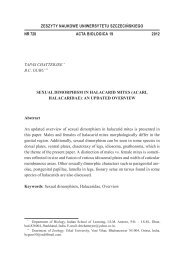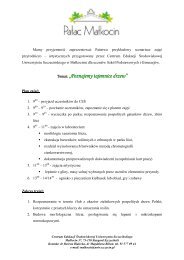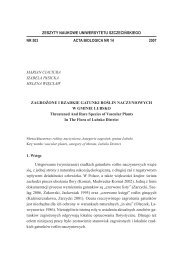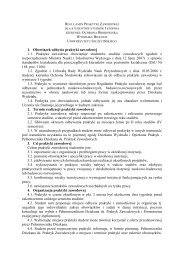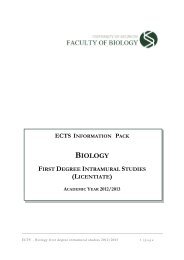7 The water mite fauna (Hydrachnidia) from three springs in ...
7 The water mite fauna (Hydrachnidia) from three springs in ...
7 The water mite fauna (Hydrachnidia) from three springs in ...
Create successful ePaper yourself
Turn your PDF publications into a flip-book with our unique Google optimized e-Paper software.
122 Andrzej Zawal, Stojmir Stojanovski, K<strong>in</strong>ga Dzierzgowska<br />
<strong>The</strong> <strong>spr<strong>in</strong>gs</strong> at St. Naum constitute a system of limnocrenes with<br />
comparatively small rheocrenes situated on their borders and surrounded by an<br />
alder riparian forest. Water discharge is rapid and abundant <strong>in</strong> these <strong>spr<strong>in</strong>gs</strong>, and<br />
has the form of a rush<strong>in</strong>g river, about 5 m wide. <strong>The</strong> bottom is covered with sand<br />
and pebbles, with Berula erecta (Huds.) Coville and Sparganium sp. grow<strong>in</strong>g<br />
<strong>in</strong> some places. Phrag<strong>mite</strong>s australis (Cav.) Tr<strong>in</strong>. Ex Steud., Typha latifolia L.,<br />
Sparganium sp. and Mentha aquatica L. grow sparsely near the river banks.<br />
Localities of sample collection: 1 – <strong>in</strong>terstitial (no <strong>water</strong> <strong>mite</strong>s); 2 – <strong>three</strong> small<br />
rheocrenes with bottoms covered with pebbles and moss and a fast <strong>water</strong> flow<br />
(no <strong>water</strong> <strong>mite</strong>s); 3 – Berula erecta on a silty bottom, slow <strong>water</strong> flow, depth<br />
ca. 0.5 m; 4 – the bottom covered with large stones and branches, slow <strong>water</strong><br />
flow, depth ca. 1 m; 5 – a patch of Sparganium with Lemna trisulca L., depth<br />
ca. 0.5 – 1 m, sandy bottom; 6 – a patch of Sparganium and Mentha aquatica<br />
<strong>in</strong> a very fast <strong>water</strong> current, gravelly bottom, depth ca. 0.5 m; 7 – sparse reeds,<br />
sandy bottom, depth ca, 1 m. Hydrochemical parameters show Table 2.<br />
Biljan<strong>in</strong>i Spr<strong>in</strong>gs – the system of <strong>spr<strong>in</strong>gs</strong> near the Hydrobiological Institute<br />
consists of <strong>three</strong> rheocrene <strong>spr<strong>in</strong>gs</strong> and streams flow<strong>in</strong>g <strong>from</strong> them. <strong>The</strong> bottoms<br />
are covered with pebbles and gravel, with Cladophora sp., Berula erecta,<br />
Sparganium sp. and Mentha aquatica grow<strong>in</strong>g <strong>in</strong> some places. Depth: 0.2<br />
–0.5 m. Localities of sample collection: 8 – a rheocrene with a slow <strong>water</strong> flow<br />
and a pebbly bottom with Cladophora sp. grow<strong>in</strong>g <strong>in</strong> some places, depth: ca.<br />
0.2 m; 9 – a stream beyond a rheocrene covered by herbaceous plants, with<br />
a gravelly bottom, depth ca. 0.3 m; 10 – an outflow <strong>from</strong> a rheocrene to a wide<br />
channel, with a pebbly and gravelly bottom, covered by Berula erecta, depth<br />
ca. 0.3 m. Hydrochemical parameters show Table 2.<br />
“Podgoricko Ezero” – Mounta<strong>in</strong> Jablanica. This is a system consist<strong>in</strong>g<br />
of two limnocrenes, a number of rheocrenes and streams flow<strong>in</strong>g <strong>from</strong> them,<br />
situated at an altitude 1850 m. <strong>The</strong>re is a large limnocrene spr<strong>in</strong>g cover<strong>in</strong>g the<br />
area of ca. 3 ha. Its lowest depth is ca. 15 m, while an average depth is 1.5 m.<br />
<strong>The</strong> bottom is covered with sand and pebbles, with large patches of Potamogeton<br />
lucens L. and Carex acutiformis Ehrh. A vast system of rheocrene <strong>spr<strong>in</strong>gs</strong> situated<br />
at 1800 m. a. s. l. is characterised by a strong <strong>water</strong> discharge and a pebbly bottom<br />
covered by moss <strong>in</strong> some places; depth ca. 0.1 m. <strong>The</strong> other limnocrene spr<strong>in</strong>g<br />
is small (ca. 0.2 ha), situated at 1700 m. a. s. l., and ca. 0.6–0.7 m deep. Its<br />
bottom is pebbly and gravelly, covered with a thick layer of silt, with Batrachium<br />
and P. lucens grow<strong>in</strong>g <strong>in</strong> some places. Localities of sample collection: 11 – the


